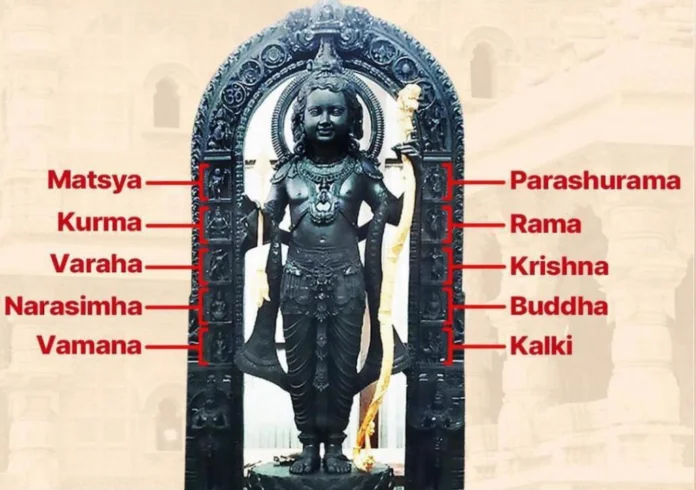
The inauguration of the Ram Mandir has been an eagerly awaited and momentous occasion for devotees of Lord Ram. Amidst the anticipation, the revelation of Lord Ram Lalla’s face has captured the hearts of millions, providing a divine glimpse into the sacred idol. Crafted by the skilled hands of Mysuru-based sculptor Arun Yogiraj, the Ram Lalla idol stands as a symbol of reverence, embodying not only the essence of Lord Ram but also featuring the ten avatars of Lord Vishnu.
The images originating from Arun Yogiraj’s workshop portray a five-year-old Lord Ram, standing gracefully with a golden bow and arrow in hand. What makes this idol truly remarkable is the intricate representation of the Dashavatara—the ten avatars of Lord Vishnu—adorned on both sides of the Ram Lalla idol.
On one side, the avatars Matsya, Kurma, Varaha, Narasimha, and Vamana grace the sacred depiction. On the other side, the avatars Parashurama, Rama, Krishna, Buddha, and Kalki stand in divine alignment. Lord Hanuman, the devoted disciple of Lord Ram, finds his place beside the right foot of the idol, symbolizing unwavering devotion. Meanwhile, Lord Garuda, the mount of Lord Vishnu, stands proudly in proximity to the left foot of the idol.
The symbolism within each avatar carries profound significance in the broader context of Hinduism and Sanatan Dharma. These divine forms bring with them blessings and positive cosmic energies, serving as a beacon of righteousness and spiritual harmony. The right hand of the idol is raised in a gesture of blessing (aashirwaad), holding an arrow, while the left hand firmly grasps a bow (dhanush), emphasizing the eternal cosmic order.
Crafted from stone and weighing approximately 150-200 kg, the Ram Lalla idol radiates a captivating divine presence. Lord Ram, depicted as a five-year-old standing on a lotus, symbolizes purity and innocence. The dimensions of the idol, measuring 4.24 feet in height and three feet in width, further amplify the divine aura that envelops the sacred creation.
Delving into the significance of the ten avatars of Lord Vishnu, collectively known as the Dashavatara, unveils a rich tapestry of cosmic events and moral teachings:
- Matsya (The Fish): Symbolizes preservation and the rescue of knowledge during the cosmic flood.
- Kurma (The Tortoise): Represents support and stability during the churning of the cosmic ocean.
- Varaha (The Boar): Illustrates the rescue of the Earth and restoration of dharma.
- Narasimha (The Man-Lion): Signifies the simultaneous existence of man and animal and the triumph of good over evil.
- Vamana (The Dwarf): Represents humility, the control of ego, and the restoration of balance.
- Parashurama (The Warrior with an Axe): Embodies the destruction of tyranny and the restoration of dharma through warfare.
- Rama (The Prince of Ayodhya): Exemplifies righteousness, duty, and adherence to dharma, as depicted in the Ramayana.
- Krishna (The Divine Cowherd): Represents divine love, compassion, and the teachings of the Bhagavad Gita.
- Buddha (The Enlightened One): Emphasizes non-violence, compassion, and enlightenment.
- Kalki (The Future Warrior): Anticipated to appear in the future, Kalki symbolizes the end of the current age, the destruction of evil forces, and the establishment of righteousness.
The Ram Lalla idol, adorned with the ten avatars of Lord Vishnu, stands as a testament to the rich tapestry of Hindu mythology and the enduring values of righteousness, duty, and cosmic balance. As devotees gather to witness the inauguration of the Ram Mandir, they carry with them not just the anticipation of a grand structure but the spiritual resonance of divine avatars, encapsulated in the sacred form of Ram Lalla.

